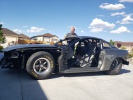Well, that's just it, I'm trying to, and at the moment it isnto following my commanded WG duty cycle. I did a bit more messing with it this morning, and it came up a little. However, I cant get my WG to go to 100% about 5500 like I'm commanding in my tables. It dips down like that picture shows.




 Reply With Quote
Reply With Quote
